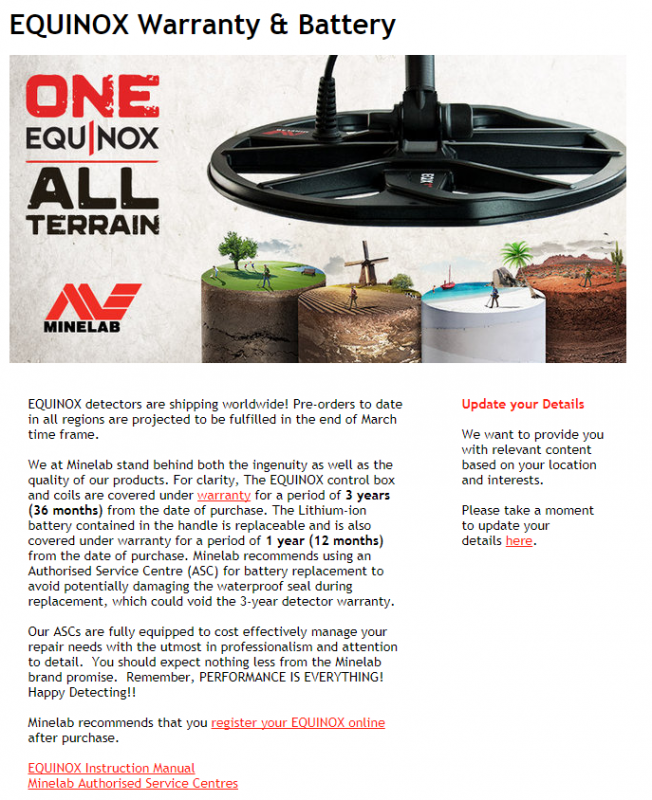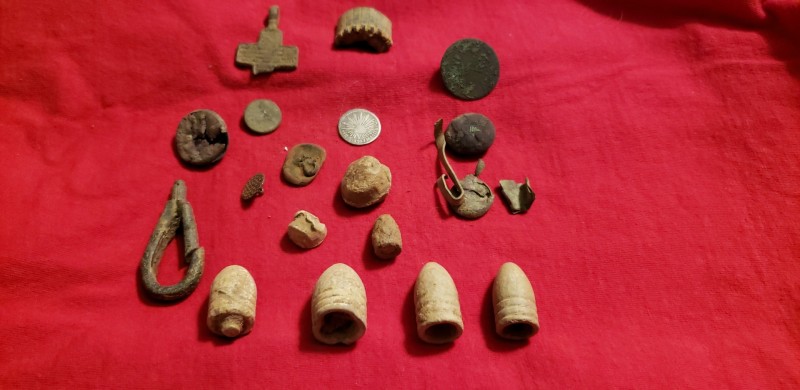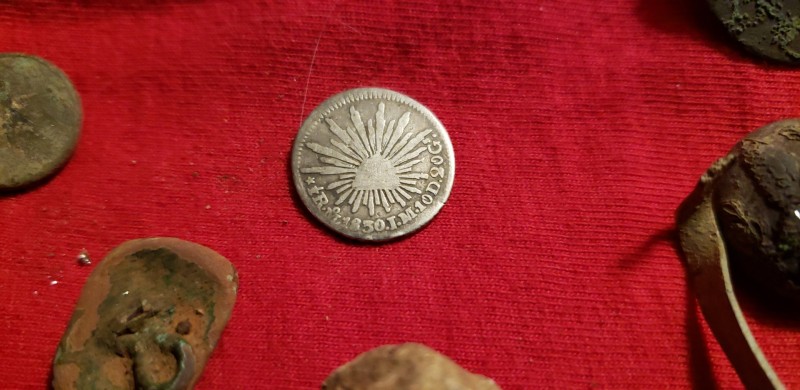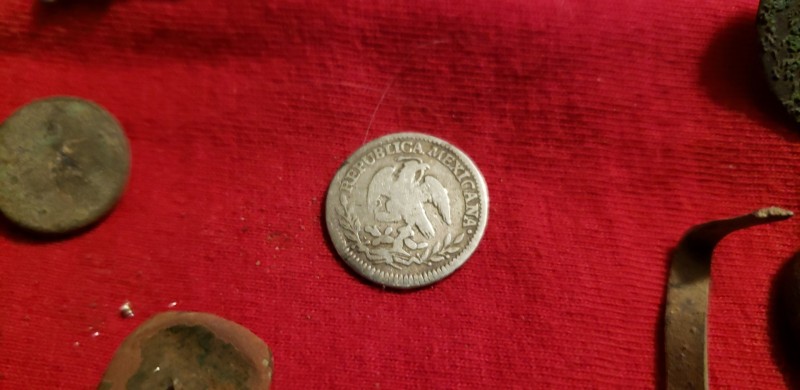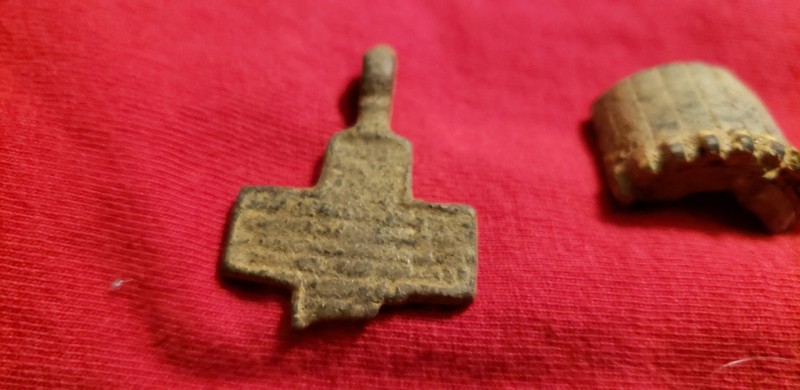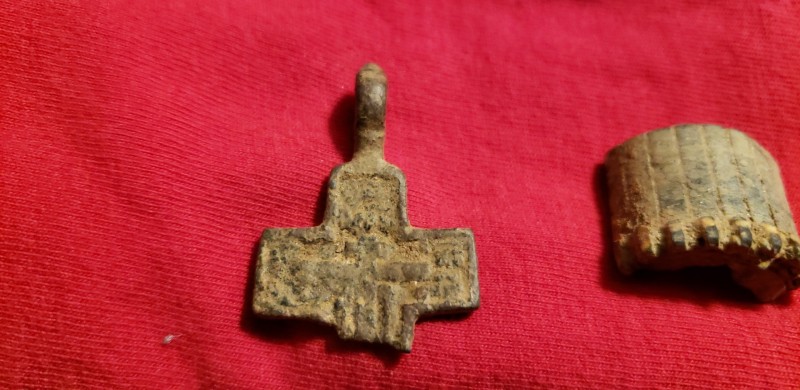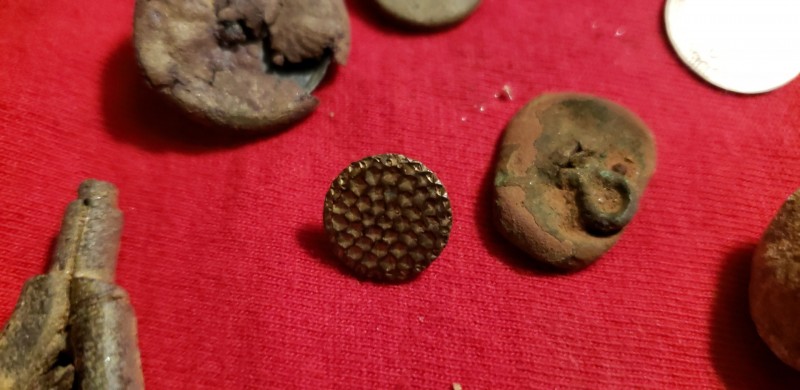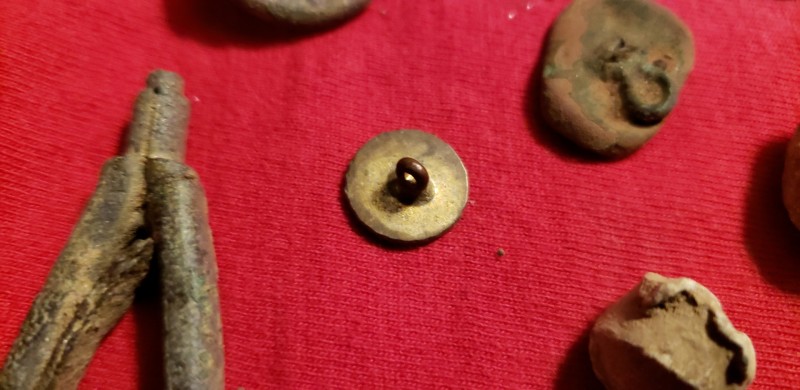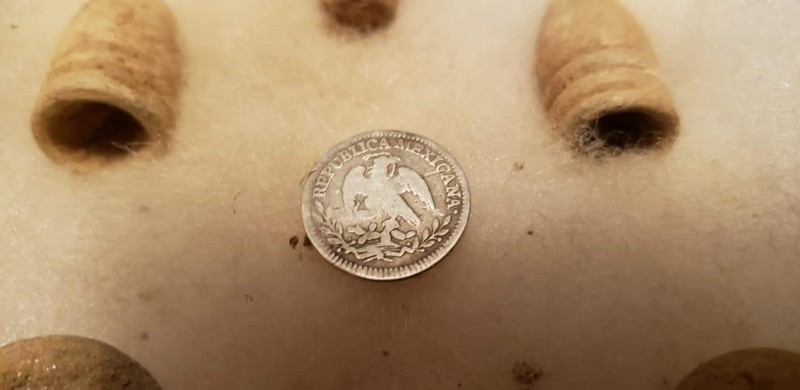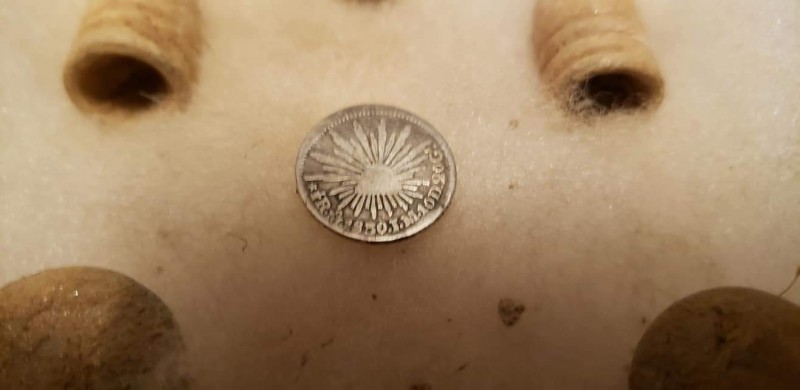-
Posts
6,131 -
Joined
-
Last visited
Content Type
Forums
Detector Prospector Home
Detector Database
Downloads
Everything posted by Chase Goldman
-

Minelab Equinox Battery Replacement Instructions
Chase Goldman replied to Steve Herschbach's topic in Minelab Equinox Forum
Just to be clear, believe this cell is Li-Ion not Lithium Polymer (LiPo). Last year Minelab sent out the following information regarding Equinox battery replacement -

Relic Hunting With The Orx Vs. The Deus
Chase Goldman replied to Chase Goldman's topic in Metal Detector Advice & Comparisons
Great question. Coins Fast on the Orx most closely resembles Deus Fast with the exception that unlike Deus Fast, which has the silencer filter turned off (-1 setting) by default, XP states that some unspecified level of silencer filtering is constantly applied in Coins Fast mode on the ORX (unlike Deus, silencer setting is not user adjustable on ORX in any mode). Though I generally like to run with silencer off on the Deus to ensure max separation performance, I really didn't notice any hindered performance on the Orx with Coins Fast and it ran with more stability than Coins Deep at this site which does have variable medium to high mineralization. Coins Deep appears to resemble Deus' Deep mode. It appears to use the Deus version 2.X deep signal processing which was re-introduced into Deus starting with version 4.2 of the Deus software (currently at version 5.21). The version 2.X processing was known to enhance deeper signals at the expense of noise and signal stability, overall. XP improved stability in version 3.X but some 2.X fans were not fans of how 3.X appeared to suppress the audible strength of deep targets, so XP brought the 2.X behavior back in the Deus 4.2 "Deep" program. It appears, XP is using "Deep" processing in Coins Deep on the ORX and without any silencer filtering whatsoever. The result is a deep but marginally stable mode option on ORX. So if you want max depth at the possible expense of more noise/less stability, Coins Deep is an option. Just as on Deus, I like to always run with some level of discrimination between 7 and 10 to mitigate ferrous down-averaging of non-ferrous target IDs. It has no affect whatsoever on depth. And unlike running with 0 disc, provides stability and reliability to the iron probability and depth indicators on ORX (or the horseshoe indicator on Deus) and with the switchable iron volume feature, keeps me from losing my low iron tone breakpoint when desired. One other "hidden feature" on ORX vs. Deus is how Target ID normalization is implemented on ORX. Users of the white HF coils know that there is no selectable target ID normalization applied whatsoever on Deus for the HF coils, unlike the LF and X35 coils where you have the choice of selecting target ID normalization (to 18 khz) on or off. ORX normalizes target IDs across the board (not user selectable) for all coils and all frequencies. This prevents high conductive target IDs from all getting jammed up into the mid to high 90's when running at 25 khz or above. HTH. -

Has Anyone Else Been Harassed Whilst Prospecting?
Chase Goldman replied to Erik Oostra's topic in Detector Prospector Forum
I don't prospect, but when detecting, I generally like to keep a very low profile whenever possible. I have not been harassed too much on the beach (mostly by intoxicated yahoos, try to keep beach hunts to the very early morning hours to avoid this and crowds, in general) and in public places where detecting is allowed. Have had some folks get mixed up on their property lines and call us on it, but we use tracking apps that clearly show the property lines of our permissions and can prove in the field that we are on the right side of our lines. Now I know my hunting buddies would harass me to no end if I was caught using "whilst" instead of "while" when conversing with them, so I tend to suppress my impulse to use literary language when out detecting with them. (Just poking a bit o fun, Erik, keep those story vignettes coming, you know two peoples separated by a common language and all that, no one here but us crude yanks ). I always keep some previously found trash in my pouch even when starting out so I can produce it in the off chance I get questioned at the beginning of my hunt in a public place and I feign disappointment in my lack of detecting skill as a detecting "newbie" - it demonstrates I do remove the junk to whoever is posing the question, and puts the thought that I might be carrying treasure somewhat out if their mind if they have more nefarious goals. A bit sneaky, but effective. -

How Far Can Coil Technology Go?
Chase Goldman replied to geof_junk's topic in Detector Prospector Forum
I agree with you to a certain extent, but the fact remains that with vlf induction balance technology, you can only go so deep. The coil really doesn't make as big a difference and I suspect manufacturers know this and do not invest a lot of research dollars into their vlf induction balance coil lines as a result. I do wish there were more choices for for elliptical style coils and concentric coils on the latest crop of vlf detectors and better cross-compatibility of coils across detector lines. Nokta seems to do the best job on this and I consider the fact that Minelab didn't do this across Vanquish/Equinox almost insulting, especially if it was driven by marketing. BTW those Fisher F75/Teknetics T2 15" coils were indeed an abomination in terms of both excessive weight and marginal performance gain for that weight penalty. PI or hybrid (e.g., GPZ) detectors are where coils can make a tremendous difference in depth performance, and if coil weight can be significantly reduced (along with reduction in weight of the electronics package) without sacrificing performance, that would be a tremendous breakthrough. The problem is that unlike antennas which can get smaller with operating frequency and needing only a single thin conductive loop to function properly (you are transmitting and sensing only the electric far-field signals), metal detecting requires producing and sensing both the electric and magnetic near-field signals, requiring several turns of conductive material to generate the transmitted magnetic field, increasing weight with every turn and since depth performance is primarily a function of the coil footprint independent of operating frequency. 3D printing and additive manufacturing technologies like the process mentioned at the top of the thread are realky taking off, can't wait to see how they might find their way into detector coil manufacturing. XP really seems to be on the forefront of incorporating modern, automated manufacturing technologies into their plant. If you could somehow marry the manufacturing and packaging innovations of XP with the detector tech and signal processing expertise of Minelab and the customer focused product line strategies of Nokta, and the social media presence of Garrett, you might really have the ideal detector manufacturer. -
I was invited back to one of my favorite relic sites in Pennsylvania for a couple of visits, recently. Not only is the site productive but you also never know what just might turn up there. There have been plates and buttons galore, minie and round balls of various types and calibers, other brass uniform and equipment accouterments, jewelry, and other relics . Not to mention silver and gold coins from the 1700's to the 20th century, including a couple of large coin caches. This site appears to have been a CW picket post and/or bivouac area. It also appears to be a center of commerce based on the number of early 19th century coinage encountered. I have had success with both the Equinox and my Deus. This site, unsurprisingly, is becoming more and more stingy and I have found that I am just more confident with the Deus here, lately, for some reason. Can't explain it from a detector performance standpoint, because the Equinox has killed it here before. The Deus in gold field or with pitch tones in discrimination mode just seems to give me a better "view" of the ground and with lots of junk iron, hot rocks, modern trash, and aluminum slag from a previous tractor engine explosion I need the instant feedback the signal modulate gives in terms of signal strength and target footprint. The Equinox lacks this "feel" with its relatively un-modulated tones and requires the extra step of shifting into pinpoint mode to trace a target footprint to sift through large iron targets and large chunks of slag or aluminum cans. The Equinox can obviously get it done here, but I am going with the hot hand, and that is XP for now.. On my second trip there this fall, I focused on using my ORX exclusively, which I got as a backup to the Deus and really wanted to see if it could hold its own with the Deus despite some of it's feature limitations vs. the Deus. The ORX has four built in programs vs. the 11 that are built into the Deus, though many of the Deus programs are just variations on the same theme with different settings pre-programmed in. The Deus and ORX basically have just two modes. Discrimination mode and Gold Field(Deus)/Gold (ORX) mode. The gold mode on Deus/ORX are essentially identical in terms of settings. Gold mode emulates an all metal setup with VCO pitch based audio that changes in intensity and pitch depending on the strength of the target signal - a visual target ID is used for dig decisions. Gold Field/Gold mode allows you to set a threshold tone and allows you vary recovery speed (reactivity) and you can cut in some limited iron audio reject which tends to break up the audio signal in the presence of iron. I usually just keep it off because in mineralized soil, everything gets broken up so it is pretty useless. You can use target ID to determine probable iron and the ORX has a useful "iron probablity" bargraph and pop up, large font target ID display which is absent on the Deus. A couple of ORX user interface enhancements I would like to see in a future Deus implementation. The discrimination or "coin modes" as they are called on the ORX are more traditional iron discrimiantion based tone and visual ID modes. On ORX the tones are fixed at 3 tones (one of those being iron audio which can be switched on even when using discrimiantion, similar to the Deus). The Deus meanwhile, has a myriad of tone customization options (1, 2, 3, 5, and full tones) with fully customizable breakpoints and tone pitch selections. The Deus also provides more adjustability on recovery speed and related filters such as the silencer which is sort of like iron bias on the Equinox. Other than those differences, the ORX raw performance is basically identical to the Deus. I decided to put that to the test and the results were not really surprising. It delivered. What did surprise me was how much I liked using it vs. the Deus. Yes it has limitations on settings but for 90% of the situations I would encounter, it would hold its own just fine. Below are some of the finds recovered recently at the site. Deus finds are mostly to the left, ORX finds are mostly to the right including the Mexican 1850 1/2 Reale. How it found it's way all the way to PA only to be lost for perhaps 150+ years, is a great mystery to be pondered. In addition to the coin, ,various Eagle buttons and button backs, a few flat buttons, a fancy gold plated button with dimpled design, a sword hanger clip, a very old religious cross pendant, period lead bullets, and some miscellaneous pieces of brass and lead were recovered. I can see myself keeping the ORX in the truck as my general purpose grab and go machine for moment's notice detecting. Enjoy.
-
If you really want to overthink it, note that with the 800, beside the master volume, you can also adjust the tone volume in each tone bin (in 2 tones and 5 tones and the ferrous and non-ferrous bins associated with 50 tones) separately. Refer to the user guide for how to do this. With this you can customize tone volumes to emphasize or de-emphasize ferrous and specific non-ferrous tones to your liking. Going further, you can also adjust tone pitches independently in a similar manner, as well. GL,
-
Welcome to the forum. You can do it either way. Increase 800 volume to max and then adjust headphone volume or just use the default master volume setting on the 800 and crank the headphones. Just play with it and see what works best for you. Either way you should be able to make it plenty loud.
-
They should.
-

Simplex Battery Questions
Chase Goldman replied to Mr Swing king's topic in Nokta / Makro Metal Detectors
Couple things here. Note that if you use third party wired phones, you will need to use the Nokta proprietary headphone connector adapter that is included in the base wired Simplex model package and the jack on that adapter fits a 1/4” plug, so if you are using wired cell phone style buds, you will need yet another mini jack to 1/4 inch plug adapter in line. Ugh. Anyway, I highly recommend going ahead and getting the wireless package now, not only because wireless phones are a game changer in convenience, but also because it will likely save you money should you decide to eventually go wireless down the road because you are likely to be able to find a dealer who can give you a hefty discount on the wireless Simplex package vs. paying full price or close to full price on an a la carte wireless headphone buy as as a stand-alone accessory later. One caveat though, unfortunately, Nokta decided NOT to include their $25 wired headphone adapter in the wireless Simplex package though it IS included in the wired package (which makes sense because you need to supply your own wired phones). So if you get the wireless Simplex package and want to use wired phones with the Simplex, for example, in rainy conditions (the wireless phones are not weatherproof, though by design you can use a rain hood while wearing them) or as a backup in the event your wireless phones’ battery drains, you have to spring extra for the adapter or get a pair of compatible wired Nokta phones (like their waterproof model). Regarding rechargeable lithium ion batteries. I have been using them in multiple detectors and detector accessories for the last 5 years and have not yet had the need to replace one yet. Embrace the convenience of that technology and rest assured that you are covered by a warranty in the mean time. Since you purchased your first detector a mere 3 mos ago and are now seriously considering upgrading, it is highly likely you will be moving on to the next best thing before your Simplex warranty runs out (2 years) and almost certainly before your Simplex battery dies of natural causes. Vendor replacement of such batteries outside of the warranty period usually runs in the ballpark of about $35 to $50 dollars depending on the material cost of the battery. Anyway, that’s my 2 cents of advice and info. GL -
Lately, the ORX/Deus (I recently obtained an ORX as a backup to my Deus), have been my preferred machine over the Equinox for serious relic detecting. I can just hear the ground better for non-ferrous targets and it gives me a better feel for the target footprint since I primarily use the gold/gold field modes vor relic hunting. The lack of tone pitch and breakpoint customization on the Orx vs.the Deus for the discrimination modes, though not a fatal flaw, is disappointing. I like the Orx large pop-up Visual TID and iron probability display vs. the Deus, though I wish the program navigation button was two-way on the Orx like it is on the Deus so you can toggle back and forth quickly between adjacent programs whike interrogating targets. Lest one thinks gold mode is just for gold, here's a an old Mexican 1850 1/2 Reale that sounded great on my Orx. Bottom line, I think you will be happy with that Orx as a compliment to the Equinox for coin and relic hunting.
-
I agree with everything Jeff said.
-

Detectorpro Headphone Toggle Size Question
Chase Goldman replied to midalake's topic in Metal Detector Advice & Comparisons
Please post back with the answer of which boots fit if anyone finds out, I am interested in this as well. -
What coil are you getting with the used Deus package? If it is one of the legacy (i.e., pre-X35) style Black LF coils your best bet is to go with a new ORX package. If you are getting a white HF coil or an X35 coil, then that sounds like a good deal provided the coil size is big enough to give you tge desired depth and/or swing coverage. The reason being, the HF coils or X35 coils can be operated at least as high as 25 khz whic is a sweet spot frequency for gold and/or mid-conductive relics (e.g., brass and lead). The maximum frequency the old legacy black LF coils can be operated is 18 khz. It makes a difference.
-

CTX Built To Be Expensive?
Chase Goldman replied to Tom Slick's topic in Metal Detector Advice & Comparisons
The best thing about CTX/eTrac is the dual Fe-CO based target ID combined with the more sophisticated ferrous-conductivity 2D discrimination patterns that can be programmed into these machines. There are some other interesting tone features built in as well such as pitch hold. But the CTX is slow, heavy, and has a flawed design with respect to it's waterproof rating, namely, the latched, gasketed battery compartment can inadvertently unlatch risking water intrusion AND you have to remove the battery to recharge itm risking gasketcwear and damage every time you do that. Furthermore, the underlying FBS multifrequency implementation has been surpassed by Multi IQ. CTX is a great (oerhaps the best) deep silver machine under ideal conditions. Mediocre on mid conductors. Throw a lot of high density junk targets its way or put it within highly mineraluzed dirt and it caould get outplayed by a Vanquish. I am waiting for ML to pursue a higher end update which combines the desirable ID, tone, and sophisticated descrimination features of the CTX with the advances in multifrequency detection and speedy/sophisticated signal processing of Multi IQ, in a lightweight but more robust waterproof package at more than half the price of CTX. -

Should I Try To Drink The Koolaid Once More
Chase Goldman replied to RobNC's topic in Metal Detector Advice & Comparisons
I have five years on the Deus and I help Andy Sabisch teach the bootcamp course for the Deus. I once believed the statement above, after today, I no longer do. The ORX can get it done as well as the Deus under any condition which just really leaves the tone tweaking you mentioned, which is really a non-issue for me because I use Gold Field or pitch tones and can easily get away with just the 3 tones option that ORX provides. I really am not left wanting with the ORX so far. I understand you were trying to provide perspective to RobNC regarding the additional audio adjustment capabilities of the Deus (what you were referring to by opening it up), but I really don't think it is worth it for him to upgrade to Deus just for tone tweaking. His money is better spent on the Equinox, but I do recommend he hangs onto the ORX.- 20 replies
-
- minelab equinox
- xp orx
-
(and 1 more)
Tagged with:
-

Should I Try To Drink The Koolaid Once More
Chase Goldman replied to RobNC's topic in Metal Detector Advice & Comparisons
If there is any way you can still hang on to that ORX and still afford the Equinox, I would do it. I just killed it a one of my favorite sites (more to follow) with the ORX (forced myself to just use it for a whole day rather than going to my old standby the Deus) and I am now starting to think that the Deus is really overkill for the way I use the Deus/ORX settings. I really prefer the ORX user interface (save for a few quibbles). I really think having both the ORX (or Deus) plus Equinox is a killer combination.- 20 replies
-
- minelab equinox
- xp orx
-
(and 1 more)
Tagged with:
-

Should I Try To Drink The Koolaid Once More
Chase Goldman replied to RobNC's topic in Metal Detector Advice & Comparisons
Hard to provide advice on your audio perception issues tough ground on a forum, really need to be in the field with you to better understand what your issues are. But I will say this, the Equinox compliments the Deus/Orx and vice versa. They are really two completely different animals with their own strengths and weaknesses. Of the T2, ORX/Deus, and Equinox - I have owned and used all three and I would personally take the T2 out of the equation for the conditions you cite - a combination of high mineralization combined with iron. That is tough for any detector and the Equinox is not necessarily going to fare any better than the Deus/ORX. Regarding ORX vs. Deus. The Deus does provide some additional tweaking ability when it comes to tones and other parameters but the ORX pretty much covers the bases for the situation at hand. If I were using the ORX in the your conditons I would be using gold field mode and let the detector tell me everything under the coil audibly and look for the non-ferrous TID that is worth digging. Using 3-tones/discrimination mode under those conditions is pretty frustrating. If I was going to use a discrimination mode setup under those conditions I would use the Deus pitch mode with iron volume but I think Gold mode on the ORX with it's iron volume (which doesn't exist on the Deus) is just as effective though I do not have sufficient run time on the ORX to be sure. Plan on doing some test runs with the ORX at a site this weekend. Unfortunately, pitch audio is an acquired taste is like all metal mode in that it doesn't really give you an audible target ID, so you are somewhat dependent on the display (same for gold mode on the Equinox) but you really know when you are swinging over a conductive target. As far as the Equinox is concerned, it really wouldn't necessarily do any BETTER than the ORX but it would be different. By that I mean, you will find things with the ORX in those conditions you won't with the Equinox and vice versa because they will communicate with you differently about what they are seeing in the ground. The advantage of Multi IQ is that you might have get slightly more non-ferrous target ID depth with the Equinox whereas the Deus will hear the target perhaps deeper but without a definitive visual target ID. Furthermore, the Equinox 800 provides a few more advantages than the 600 in these conditions. Beside the wider range of settings with respect to iron bias and recovery speed, the higher single frequency options, and the non-ferrous tone customization options, one additional not-so-secret weapon that Equinox has in tough dirt/thick iron is Gold Mode. I use that a lot and it sort of emulates the ORX/Deus pitch tone or gold field mode pitch audio, but not quite as good. I like having the Equinox user profile button available so that I can quickly switch between modes (e.g., Field 2 and Gold mode) to interrogate iffy signals. So that is an advantage of Equinox. I could go on, but not sure I am really helping because I don't fully understand your issues. But as far as kool aid is concerned, Deus/ORX and Equinox just have different flavors and variety is the spice of life. How's that for worthless platitudes. Good luck Rob.- 20 replies
-
- minelab equinox
- xp orx
-
(and 1 more)
Tagged with:
-

50 Tones Default - Tone Pitch 20 Vs 25
Chase Goldman replied to Happa54's topic in Minelab Equinox Forum
Mitchel - despite the confusion on the CTX tone break setting, I appreciate your efforts to resurrect Gordon’s setups and provide the PDF link as it gave me some good for thought on other possible setups. TBH I am not personally looking to have my Equinox emulate a CTX or FBS machine audio, but Happa and you have made me think more about tweaking the the 50 tone pitch gap to better accommodate my hearing loss. Thanks to everyone who contributed in this thread. -

Just Got My Simplex Went For A Walk
Chase Goldman replied to wltdwiz's topic in Nokta / Makro Metal Detectors
I take it that is a freshwater beach? -

Sporting Goods Store Detector Sales
Chase Goldman replied to Ridge Runner's topic in Metal Detector Advice & Comparisons
Bingo. I don't care whose selling me the detector retail shop or dealer, as long as the source is reputable and I am getting the best deal. I’ll read a book, use the forum, or ask a fellow detectorist if I need after sale help. That being said, it just so happens that the two primary dealers I happen to do business with generally do have the best deals, are knowledgeable, and I have also detected with them in the field. I just consider myself lucky in that regard because I know that is generally not the norm. Frankly, the biggest impediment to a newbie making detecting a sustained hobby is not the detector learning curve or after market ”support”. In the US, at least, it’s restricted site availability. In order to get sustained access you really need to do beach hunting, door knock, or have access to a network of detectorists or clubs or organizations that share sites or provide organized hunts. Public access to detectorists is quickly being eroded by municipal laws prohibiting detecting due to misguided notions of what detecting is all about combined with really poor behavior by some detectorists (trespassing, not filling holes, etc.). Detecting your lawn gets boring quick. After that, once a budding detectorist realizes that most of the time he is going to be digging trash and junk (and how physically draining target recovery is, in general) even after he nearly masters his machine and does get access to productive sites, that’s usually the make or break moment where the hobby either catches on or the machine ends up in the closet. -

50 Tones Default - Tone Pitch 20 Vs 25
Chase Goldman replied to Happa54's topic in Minelab Equinox Forum
Sorry, but this still doesn’t satisfactorily explain why the PDF version of Gordon’s 4 Equinox programs explicitly calls out 2 tone breaks for the 50 tone ‘CTX Tones’ program and also has the tone pitch setting (also known as pitch gap in the 50 tones context) at 1,20 which is the 50 tone default setting. The explanation above is basically just restating what is already in the manual regarding how to close the ferrous/non-ferrous pitch gap and has no correspondence to his published ‘CTX Tones’ progam settings. So...I’m still confused as to how CTX Tones should be set up. -

Could Not Make Eqx To See The Target
Chase Goldman replied to nordic's topic in Minelab Equinox Forum
Since you ruled out 1.5, did you make that decision to go with 1.75 over 2.0 by thoroughly/exhaustively testing Fe vs. F2 iron bias settings? Otherwise, there should be practically no difference in baseline performance between 1.75 and 2.0 given identical user settings including Fe iron bias. The main performance difference between 1.75 and 2.0 is the F2 bias setting and since 2.0 includes the legacy Fe settings as well as the F2 settings, 1.75 brings practically nothing to the table over 2.0 performance wise and the 1.5 to 1.75 update was the one that changed baseline detector performance with respect to low profile (e.g., edge-on coin) target performance. That is just simple straight forward logic. I suppose one could challenge the assertion whether the “baseline” (i.e., non F2 iron bias) performance is identical between 1.75 and 2.0 but ML’s admittedly vague description of the 2.0 changes doesn’t imply anything beyond the addition of F2 and the backlight enhancement for the 600 and perhaps some low level underlying bug fixes. -

50 Tones Default - Tone Pitch 20 Vs 25
Chase Goldman replied to Happa54's topic in Minelab Equinox Forum
? You can only set one tone break when in 50 tones so I don’t understand this recommended setting. Should it just be T1=12? -

Could Not Make Eqx To See The Target
Chase Goldman replied to nordic's topic in Minelab Equinox Forum
Noridc, Couple of thoughts. First of all, I agree with you. No one should lose any sleep over which version to use. They are ALL acceptable and get the job done. I have found awesome (and deep) stuff with each and every version. If the masses perceived that the subsequent Equinox updates actually reduced depth, I think we would certainly be hearing about it en masse. That doesn't appear to be the case. Sometimes, things are just circumstantial or you run into an extended cold streak and the perception is something has changed with the detector (for the worst) and most of the time it really just turns out to be dumb luck or poor site selection. Finally, remember that no one detector DOES IT ALL. Equinox like every other detector out there is not perfect. Neither is Deus. But there is something to be said of diversity in detecting equipment and I find for me that Deus and Equinox make a great combination if I have the luxury to hit a site multiple times or have the time to go over the site with both detectors. Also, sometimes you just have to acknowledge that under certain situations one detector is truly superior to the other. I prefer Deus over Equinox in thick iron situations. I prefer Equinox at salt sand beaches. Otherwise, there is a lot of overlap and I find the detectors compliment each other. Final note, regarding that user profile button. I find it VERY useful to quickly interrogate iffy signals with diverse Equinox detection modes before I dig the target. If I get an iffy signal on Field 2, I may have Gold mode or Park 1 loaded up in the user profile slot. Sometimes that can may an iffy target turn into a definite dig me signal. I also use Pinpointer to help characterize the footprint of the target (in fact, I rarely use pinpoint to actually pinpoint a target because I feel I can pinpoint better by wiggling the coil edge off the target). Good luck and HH! -

50 Tones Default - Tone Pitch 20 Vs 25
Chase Goldman replied to Happa54's topic in Minelab Equinox Forum
The link in your 2018 post no longer works, at least not for me.


